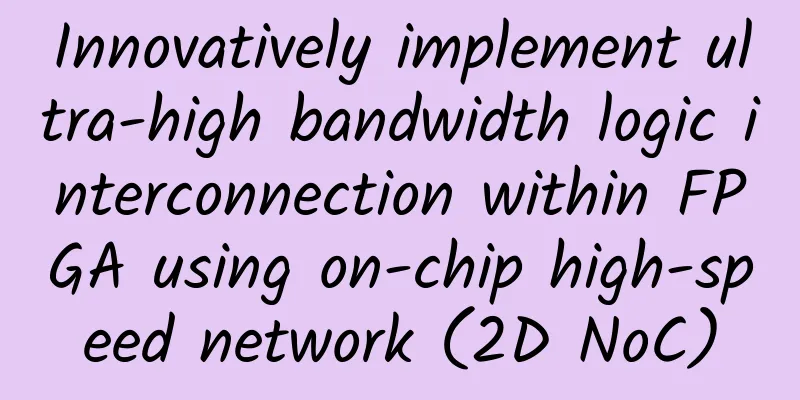Innovatively implement ultra-high bandwidth logic interconnection within FPGA using on-chip high-speed network (2D NoC)

|
An example of using NoC to optimize encryption and decryption design Achronix's latest Speedster7t FPGA device based on TSMC's 7nm FinFET process includes a revolutionary new two-dimensional on-chip network (2D NoC). 2D NoC is like a highway network running on the FPGA programmable logic structure, providing ultra-high bandwidth (~27Tbps) for data transmission between FPGA external high-speed interfaces and internal programmable logic. Figure 1 Speedster 7t FPGA structure diagram The NoC distributes data across the FPGA using a series of high-speed row and column network paths, distributing data traffic horizontally and vertically across the FPGA fabric. Each row or column in the NoC has two 256-bit, unidirectional, industry-standard AXI channels that can run at a transfer rate of 512Gbps (256bit x 2GHz) in each direction. NoCs offer several important advantages for FPGA design, including:
This article uses a specific FPGA design example to show the important role that NoC plays in the internal logic interconnection of FPGA. This design mainly implements the triple data encryption and decryption algorithm (3DES). This algorithm is a mode of the DES encryption algorithm. It applies the DES encryption algorithm three times to each data block and increases security by increasing the key length of DES. In this FPGA design, we place the input and output pins in the four directions of the FPGA, top, bottom, left, and right. The data coming in from the top pin is decrypted by logic 1 and then sent to logic 2 through the blue trace for encryption before being sent out from the bottom pin. The data coming in from the left pin is decrypted by logic 3 and then sent to logic 4 through the red trace for encryption before being sent out from the right pin. As shown in Figure 2. Figure 2 Backend layout and routing diagram of 3DES design (without NoC) The problems encountered in this design are as follows:
The above two problems are also problems that most FPGA designers will encounter more or less in complex FPGA designs. The reasons may be that the design is more complicated, or it may be the limitation of the hardware platform, or the design must connect to peripheral Hard IP in different locations. The emergence of NoC solves the above problems. NoC provides a bidirectional 288-bit raw data mode for the internal interconnection of FPGA logic. Users can use this 288-bit signal to directly connect logic or use custom protocol interconnection. Figure 3 Using 2D NoC for internal logic interconnection There are two network access points (NAPs) at each intersection of the NoC. Users can connect their own logic to the NoC and interconnect them simply by instantiating the primitives or macro definitions of the NAPs. Figure 4 Network Access Point (NAP) Figure 5 Example of instantiating NAP macro definition In this way, by instantiating NAP on the 3DES encryption and decryption modules respectively, the NoC interconnection between the 3DES encryption and decryption modules can be realized. Figure 6 3DES design (using NoC) back-end layout and routing diagram This simplifies the user design while greatly improving the design performance from 260MHz to 750MHz. As shown in Figure 6, the large number of connection buses between logics are no longer visible. The bus connections are taken over by the NoC. Only the green clock routing and the white logic routing inside the module can be seen in the back-end layout and routing diagram. This article mainly wants to show FPGA designers how to use NoC to interconnect the internal logic of FPGA through such an example, so as to provide FPGA designers with another way of thinking. When the performance cannot be improved and the layout and routing are congested in traditional FPGA design, can we consider using Achronix's new generation Speedster7t FPGA to simplify and accelerate the user's design? |
<<: Unified Communications Market Trends Drive Spending Growth
>>: In the tug-of-war between NetOps and SecOps, what role does SD-WAN play?
Recommend
In the 5G era, closed systems are also dangerous. There is no chance to upgrade or patch.
As traditional industrial control systems and equ...
Overcoming the Security Challenges of Software-Defined Networking
Today, more and more organizations are embracing ...
A brief tutorial on the Dig command
Hello everyone, I am Xianyu. I don’t know how oft...
Ovum Observation: SDN/NFV Significantly Reduces Time to Market for Services of Operators in Emerging Markets
Early morning news on January 11, for communicati...
Why do 5G mobile phones support more frequency bands?
How many 5G frequency bands a mobile phone can su...
Starting next year, your home router should be upgraded to Wi-Fi 6!
This article is reproduced from Leiphone.com. If ...
How high is the spectrum efficiency of 5G?
Wireless spectrum is the most valuable resource f...
China Unicom and its partners release the Trusted Network White Paper
On July 9, 2023, China United Network Communicati...
5G, which frequently appears on hot searches, has really "broken the circle" in 2021!
It has been two years since the 5G license was is...
What will happen when 5G network falls in love with public cloud?
[[410935]] Recently, AT&T, the second largest...
IPv6 has a "red" start, and Internet giants are showing their talents!
After "getting up early and arriving late&qu...
New IT Navigation: SDN shifts from technology-driven to application-driven
The energy of digital technologies represented by...
HostDare: $15.56/half year-756MB memory/35GB hard disk/600GB monthly traffic/Los Angeles data center
HostDare has launched this month's promotion,...
Boomer.Host: Cheap VPS in Houston starting at $3.50 per year (low price and low configuration)
Boomer.Host is a relatively new foreign hosting c...
What will 5G rely on to disrupt data centers?
In a January 2017 survey, research firm IHS Marki...









